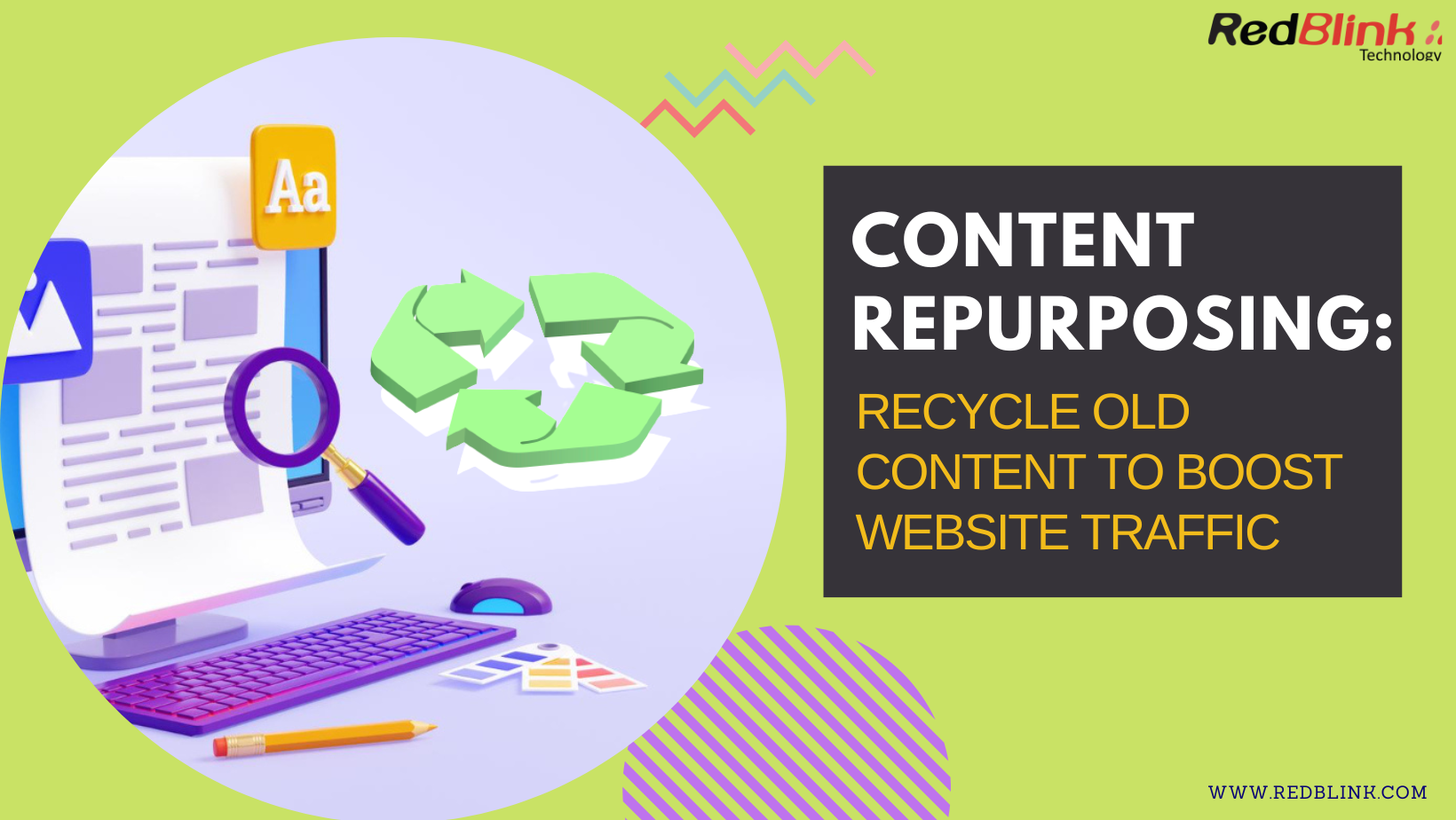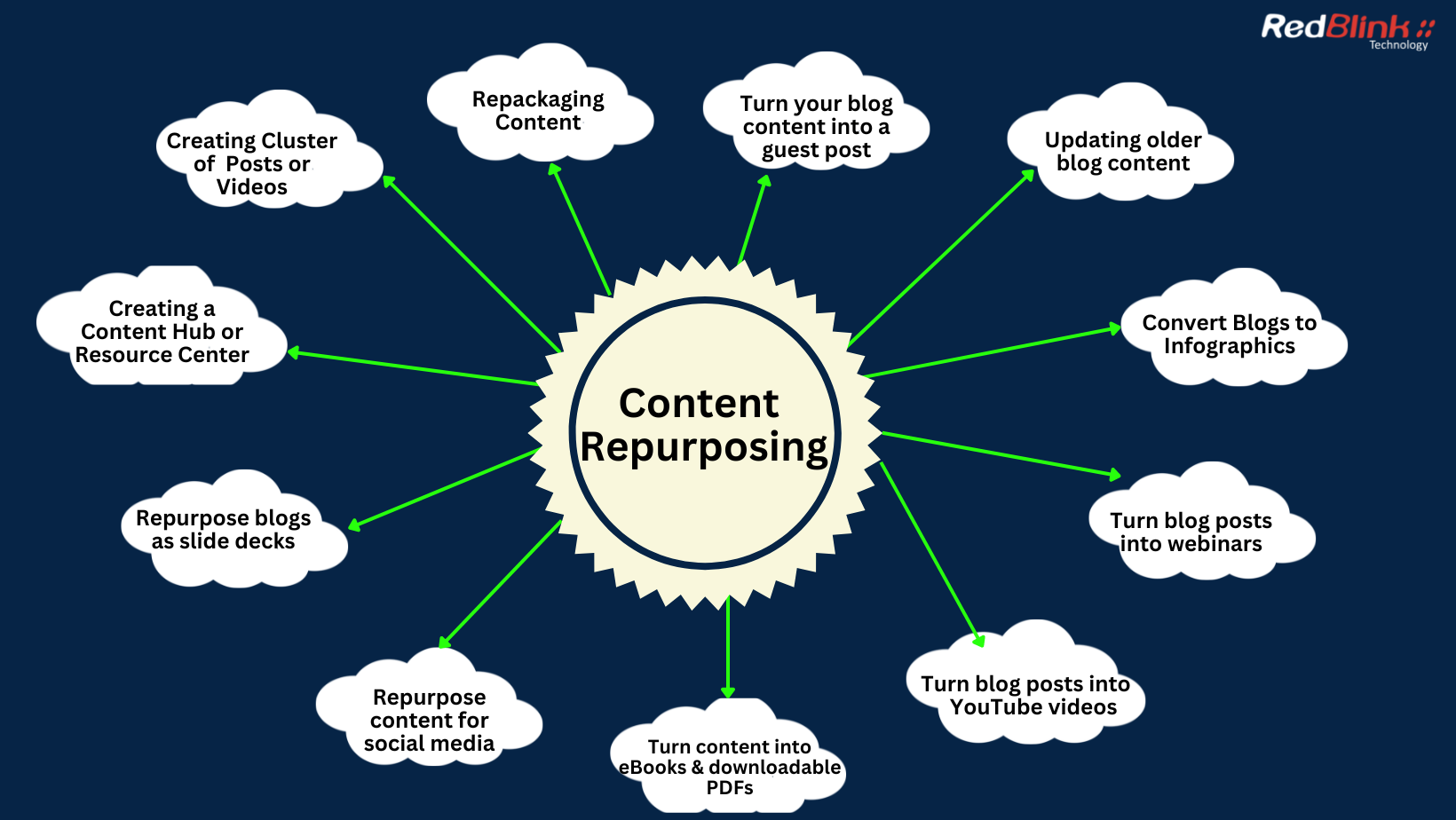Content Repurposing
“Successful content is not about creation, but about curation.” – Ann Handley, best-selling author, and chief content officer.
Content creation is a continuous process. Don’t let your hard work go to waste! With time, any content can become obsolete and do not match the current trends. So , to make it worthwhile, it needs some kind of refurbishment to stay ahead of competition on Google search and new content being generated every now and then. Thats why its very essential to transform your massive blog post, white papers, or industry trends report from a one-time hit to a long-term asset.
With content repurposing, you can maximize your content-creation efforts, save time, and increase your conversion rate. Imagine giving new life to your older content and reaching an entirely new audience.

Producing new content ideas is not an easy task. And sometime it becomes difficult for writers and marketers to produce new ideas. So to we can, Instead of producing fresh content every time, content writers can recycle old content which has caused some decline in its organic traffic. The repurposing and recycling of content allows already written content can be tweaked with some latest trends, news or stats etc to meet the expectations of each marketing channel.
By reading this post, you will learn how to squeeze more value from the quality content you’ve been creating.
What Does It Mean To Repurpose Content?
Content repurposing refers to the process of modifying existing content and adapting it to create new forms of content. The new content is distributed through different channels to target new/different audiences. This involves making changes to the format, medium, or message of the content to maximize its reach and effectiveness.
According to a survey by Semrush, 51% of marketers reported that repurposing content had the highest impact on their content marketing success in 2020.
(Source: Semrush, “The State of Content Marketing Report 2020” )
Benefits of Repurposing Your Content
By giving new life to your existing content, you maintain consistent branding without the stress of constantly creating new content. Plus, you can cater to your audience’s diverse content preferences by repackaging your content into different formats. And let’s not forget the SEO boost!
Also Read: How to Build a Brand From Scratch – Branding Strategies Guide
Let’s look at some more benefits of recreating your content:
-
Boost Content Distribution
By changing the format of your content (e.g. from written to audio), you can reach more people. To promote content, the latest trend is to convert written blog posts and articles to audio and video files. Also, some of the content is rephrased with the help of Podcasts.
-
Consistent Publishing and Online Presence
Repurposing content allows you to keep publishing high-quality content on different channels without constantly creating new content. The SEO team keeps track of the ranking content. Once you know the exact expectation of end users from your brand. You can recreate the content in more effective ways.
-
Meet Audience Needs
Not everyone prefers the same content format. By repackaging your content into various formats, you can cater to a wider audience. For example, by picking up the highlights of a blog post, you can easily create an engaging social media post.
-
Reach a New Audience
Share your content on different marketing channels by adapting it to each channel’s requirements.
According to a survey conducted by ReferralRock, 94% of surveyed marketers repurpose their content, and the remaining 6% are thinking about doing so in the future.
-
Boost SEO Results
Having multiple pieces of content for the same keyword can improve your search engine optimization as well. Also, you can control the backlinking o your site through the repurposed pieces.
According to a study by HubSpot, businesses that published 16 or more blog posts per month received 3.5 times more traffic than those that published 0-4 monthly posts.
Additionally, a survey by Orbit Media found that the average blog post takes over 4 hours to write while repurposing existing content can take significantly less time.
Evaluating Your Existing Content
Content marketing is an essential aspect of digital marketing, and it requires continuous efforts to produce content. To keep your content strategy relevant and effective, you need to evaluate your existing content periodically.
Also Read: 2024 Micro-SaaS Trends & Ideas To Use for Business Productivity
Here’s how you can go about it:
-
Identify High-Performing Content
Your high-performing content is the one that has been most successful in engaging your audience, driving traffic to your website, and increasing your conversions. To identify such content, you can use analytics tools such as Google Analytics to measure the performance of your blog posts, social media updates, and other content pieces.
Look for content that has high page views, low bounce rates, high engagement rates, and high conversions. Once you identify the high-performing content, you can replicate the strategies that worked for those pieces in your future content.
-
Understand Your Audience’s Preferences
To create content that resonates with your audience, you need to understand their preferences. Analyzing your audience’s behavior and demographics can help you understand their preferences better.
Tools like Google Analytics can provide you with insights into your audience’s interests, search queries, and social media activities. Use this information to create content that addresses your audience’s pain points and interests, and in a way that they find most engaging.
-
Identify Content Gaps
Content gaps are topics or themes that your audience is interested in, but you haven’t covered yet. Identifying content gaps can help you create new content ideas that resonate with your audience.
You can identify content gaps by analyzing your competitors’ content, using social listening tools to monitor your audience’s conversations, and conducting keyword research. Once you identify content gaps, you can create content that fills those gaps and provides value to your audience.
Repurposing Content: Strategies and Techniques
Repurposing content is an important step in your content automation. To identify content to repurpose:
- Highlight evergreen content from old blog posts.
- Repurpose all-new long-form content as part of your content creation process.
- Find posts driving significant traffic using Google Analytics.
- Use Buzzsumo to identify socially popular topics.
- Do keyword research to identify content to repurpose.
In the end, light up your content with the power of repurposing. Nowadays, rewriting and NLP content writing tools are available to help you recreate the content saving time and effort.
Repurposing content allows you to get the most out of your content by using it in different ways, thereby increasing its reach and impact.

Here are the simple ways to get started with repurposing your content:
-
Repurpose blog content as slide decks
If you have any new skyscraper content, consider using it as a starting point for a slide deck on LinkedIn or Slideshare. A slide deck can be a great way to restate key points or summarize important statistics from your blog post. Consider using quotes from experts, actionable tips, or research-backed statistics to make your slide deck even more appealing.
-
Repurpose content for social media
You can also take your blog posts and repurpose them as social media images to promote on different platforms. This can be a great way to drive more engagement and increase awareness for both new and older content.
Consider using interesting tidbits or actionable advice, research-backed data or statistics, or quotes from experts to make your social media content more appealing.
-
Convert blog posts into eBooks and downloadable PDFs
If you have multiple blog posts on the same topic, consider combining them and repurposing the content as an eBook or a downloadable PDF. This can be a great way to increase leads generated from your blog. Consider using the content to create free content upgrades like eBooks, checklists, PDFs, or DIY templates.
-
Repurpose content as YouTube videos
If you have educational content, interviews, events, or webinars, consider repurposing and uploading them on YouTube. With the right video optimization in place, your videos will not only show up on YouTube, but also on Google’s search results. This can be a great way to attract new blog readers, increase product sign-ups, and more.
-
Turn blog posts into webinars
If you have a collection of blog content on a specific topic that readers enjoy, consider repurposing that content as a conversion-focused webinar. Webinars are typically used for lead generation, so this can be a great way to generate more leads from your existing content.
-
Convert Blogs to Infographics
Infographics are the king of social engagement, with a whopping three times more likes and shares than other types of content.
According to a research study by Mention, which analyzed 11 billion social media mentions, infographics are a powerful way to present complex information in a digestible format, increase social shareability, and boost brand awareness.
While starting with infographics , you can consider:
-
- Take your highest-performing blog posts and create an infographic version to accompany them.
- Revamp your older blog posts with fresh, up-to-date information and accompany them with a visually appealing infographic.
- If you have conducted original research, summarize your findings in an infographic to increase social media sharing and secure press mentions.
-
Updating older blog content
Creating engaging blog posts is an easy way to increase organic rankings and website traffic.
Dan Fries, founder of BlueTree.AI, states that updating outdated content makes it relevant again and can help boost your search engine rankings.
-
- Identify your highest-performing content that is older than six months.
- Update only evergreen content, which remains relevant for readers over time.
- Identify the most outdated content pieces that need a refresh.
-
Turn your blog content into a guest post
To increase brand visibility, attract links, and drive traffic.
Here’s are tips to implement while creating guest posts:
-
- Identify sections in your guide that can stand alone as guest posts.
- Find high-authority websites in your niche that accept guest contributions.
- Pitch your ideas, write the guest post, and link back to your original guide.
A great example of this strategy in action is a piece about the latest graphic design trends. It has been featured on websites such as CampaignMonitor, GoSkills, Mention, and Millo. To get started, revisit your blog archives and find content that could be rephrased and repurposed into a series of guest posts.
Also Read: Importance of Good Web Design : How it can help your Business
-
Repackaging Content
Revamp and repackage your content to give it a new lease of life! By breaking down your content into smaller, manageable chunks, you can create a cluster of posts and videos for better engagement.
Another option is to bundle your content into an ebook or webinar, offering your audience a comprehensive resource in one go. You can also create a content hub or resource center, where you compile all your content in one place for your audience to explore at their own leisure.
By repackaging your content, you’re not only making it more accessible to your audience but also increasing its longevity and value.
-
Creating Cluster of Posts or Videos:
Repackaging content into a series of blog posts or videos can help create a more engaging and easily manageable format to cater to the needs of users. The revamped post includes the answers to the people’s queries.
-
Bundling Content into an Ebook
Another way to repackage content is to bundle it into a comprehensive guide or resource, such as an ebook.This format provides a comprehensive overview of a particular topic and can be a great way to showcase your expertise and build your brand.
-
Creating a Content Hub or Resource Center
A content hub or resource center is a central location on your website where all of your best content is housed and easily accessible. This type of repackaging allows you to keep your content organized and ensure that your audience has easy access to your best work.
By showcasing your content in a content hub or resource center, you can improve engagement, increase website traffic, and build a stronger brand.
Repackaging Content: Formats and Channels
Repackaging content involves taking existing content and presenting it in a new format or on a different channel. By doing so, you can reach new audiences, increase engagement, and get more value out of your existing content.
When repackaging content, it’s important to choose the best format for your content, repurpose it for different social media channels, and create visually appealing content.
-
Choosing the Best Content Format
Understanding the purpose of content publishing is the most important activity in digital marketing campaigns. For example, old blogs can be converted into videos, infographics, or presentations for better user engagement.
-
Replacing Content on Different Social Media Channels
Each social media platform has its strengths and limitations, so you should adapt your content accordingly. For example, you can repurpose a blog post into a series of tweets or an infographic for Twitter, or create a short video clip or a carousel for Instagram.
-
Creating visually appealing content
Visual content is more engaging and memorable than text-based content, so you should incorporate visual elements into your repackaged content. This can include images, videos, infographics, or other interactive elements.
Best Practices for Content Repurposing
Repurposing content is an effective way to get the most out of your existing content while saving time and effort in creating new content.
Here are some best practices to follow:
-
Avoid Duplicate Content Issues
Duplicate content can harm your website’s search engine rankings and can lead to penalties from search engines. To avoid this, you should avoid duplicating content verbatim across different pages or platforms. Instead, you should reword the content, update the information, and make it unique.
Also, make sure to include canonical tags on repurposed content pages to indicate the home source of the content.
-
Optimize Repurposed Content for SEO
Optimizing repurposed content for SEO can help you improve your search engine rankings and drive more traffic to your website.
To do this, you should identify relevant keywords for your repurposed content and include them in the content’s meta tags, heading tags, and body text. You should also make sure that the repurposed content is mobile-friendly, has a fast loading speed, and is structured for easy readability and navigation.
Also Read: ChatGPT Open AI For Beginners – What is it & How to Use It?
-
Measure the Success of Repurposed Content
Measuring the success of repurposed content can help you identify which types of content perform well, what channels are most effective, and which repurposing strategies are most successful.
You can use analytics tools to track the performance of your repurposed content, such as page views, engagement rates, and conversions. This information can help you fine-tune your content repurposing strategy and make informed decisions about future content creation. You can start repurposing of your content plan by creating content calendar.
Final Thoughts on Maximizing Content Repurposing Impact
In conclusion, content repurposing is a powerful strategy for maximizing the impact of your digital marketing efforts. By repurposing existing content, you can reach a wider audience, reinforce your brand messaging, and boost your lead generation strategy.
To fully realize the benefits of content repurposing, it’s important to work with a knowledgeable and experienced digital marketing team. A team that can help you identify the best content pieces to repurpose, determine the most effective formats and channels for reaching your target audience, and track your results to continually improve your strategy.
If you’re ready to take your digital marketing efforts to the next level and start maximizing the impact of your content, schedule an appointment with our Digital Marketing team today. Our team of experts can help you develop and execute a comprehensive content repurposing strategy that drives results and supports your overall marketing goals.
Don’t wait, schedule your appointment now and let’s get started!

Director of Digital Marketing | NLP Entity SEO Specialist | Data Scientist | Growth Ninja
With more than 15 years of experience, Loveneet Singh is a seasoned digital marketing director, NLP entity SEO specialist, and data scientist. With a passion for all things Google, WordPress, SEO services, web development, and digital marketing, he brings a wealth of knowledge and expertise to every project. Loveneet’s commitment to creating people-first content that aligns with Google’s guidelines ensures that his articles provide a satisfying experience for readers. Stay updated with his insights and strategies to boost your online presence.
